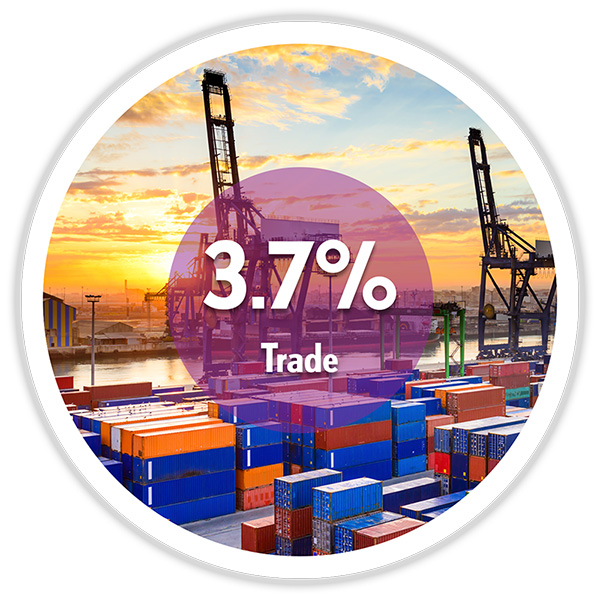China's GDP posts faster-than-expected growth
China’s economy remained stable in the first quarter, with the gross domestic production posting a faster-than-expected growth year on year, as industrial production jumped sharply and consumer demand showed signs of improvement.
GDP
China's gross domestic product rose 6.4 percent year on year to 21.343 trillion yuan in the first quarter of 2019. The growth pace was the same with that of the last three months of 2018.
Industrial production (ID)
China's industrial output expanded 6.5 percent year on year in the first quarter, picking up from the 5.3-percent growth in the January-February period.
Fixed-asset investment(FAI)
China's fixed-asset investment grew 6.3 percent year on year in the first quarter of 2019, 0.2 percentage points faster than the first two months.
Retail sales
China's retail sales of consumer goods rose 8.3 percent year on year in the first quarter of the year. The growth quickened from an increase of 8.2 percent registered in the first two months.
Trade
China's foreign trade increased 3.7 percent from a year earlier to 7.01 trillion yuan in the first quarter.
The GDP rose from a year earlier to 21.3433 trillion yuan (US$3.1885 trillion) in the first three months, up 6.4 percent, which was unchanged from the fourth quarter of 2018 and higher than the expected 6.3 percent, according to the National Bureau of Statistics.
On a month-on-month basis, the GDP grew 1.4 percent in the first quarter as expected, retreating slightly from the 1.5 percent growth posted in the previous quarter — a new low since the first quarter of 2018.
The bureau said the market expectations have markedly improved and confidence in development had increased.
China’s economy operated within a reasonable range in the first quarter. The positive factors gradually increased, laying a good foundation for steady economic development throughout the year, said Mao Shengyong, spokesperson for the NBS.
However, the acute structural imbalance and downward pressure still exist, Mao said, adding that greater efforts should be made in further promoting reforms.
China has rolled out many policies to support growth — the key is to implement them, Mao said.
Share markets and most currencies in Asia rose in relief, as China’s slowdown has increasingly weighed on its trading partners from Japan to Germany. The yuan currency rose 0.4 percent to a 7-week high, Reuters reported.
The value-added industrial output of designated large enterprises — with an annual turnover of at least 20 million yuan — grew 6.5 percent year on year in the first quarter, dipping 0.3 percentage points from the same period last year.
The figure was up 1.2 percentage points compared with the January-February figure, and was 0.8 percentage points faster than the fourth quarter last year.
For March, the value-added industrial output of major enterprises grew 8.5 percent year on year, 3.2 percentage points faster than the January-February period, and rose 1 percent from the previous month.
The March year-on-year pickup was mainly driven by the mining and manufacturing sectors, according to Nomura, where industrial output growth rose to 4.6 percent year on year and 9.0 percent respectively in March from 0.3 percent and 5.6 percent in the January-February period.
Industrial output growth in the utilities sector also rose last month, albeit less significantly, to 7.7 percent from 6.8 percent in the first two months.
By industry, output in the mining sector percent grew 2.2 percent year on year in the first quarter, that in the utility sector rose 7.1 percent and the manufacturing sector rose by 7.2 percent.
Of note, the industrial high-tech sectors jumped 7.8 percent in the first three months from the same period last year, 1.3 percentage points faster than the overall figure for the industrial production of major enterprises.
The emerging industrial sectors also rose at a 0.2-percentage-point faster pace than the headline industrial output figure, rising 6.7 percent from a year earlier.
The service sector expanded steadily by 7 percent year on year in January-March to 12.2317 trillion yuan.
Among them, the leasing and business service sector increased by 8.3 percent year on year, the financial sector up 7 percent, the accommodation and catering sector grew 6 percent, and wholesale and retail sales advanced by 5.8 percent, all higher than the pace in the fourth quarter of last year.
The information transmission, software and information technology service industry extended its rapid growth, jumping 21.2 percent.
Fixed asset investment grew by 6.3 percent year on year in the first quarter, an acceleration of 0.2 percentage points compared with January-February, but fell from the 7.5 percent year-on-year growth in the first quarter last year.
Retail sales growth ticked up to a stronger-than-expected 8.7 percent year on year in March from 8.2 percent in January-February. However, passenger car sales growth was deep in the negative category, dropping by 11.7 percent in March from a year earlier, against the 9.7 percent year on year decline in January-February.
Sales growth of property-related products rose broadly, mainly led by home-use electronics and furniture sales, growth of which jumped to 15.2 percent year on year and 12.8 percent, respectively, in March from 3.3 percent and 0.7 percent in January-February.
“The improved sales of property-related products was largely due to the ongoing recovery of the property sector in big cities, although we believe it is likely to be moderate and short-lived,” Nomura said in a note.
“We remain cautious on property markets of lower-tier cities, as downside pressures still loom, especially from tapering pledged supplementary lending, contracting land sales and rising bond repayment pressures amid mounting outstanding debt for developers. This does not bode well for consumption growth in upstream and downstream industries of the property sector in coming quarters,” said Lu Ting, chief China economist of Nomura.
“As the growth momentum of the Chinese economy picks up, we believe that policymakers will assess the need for further stimulus. The government will maintain a counter-cyclical stance, which will primarily be expressed through measures that support structural transformation,” according to the Australia and New Zealand Banking Group.
The ANZ Group expected a recovery in the second quarter to be largely domestically stimulated, with investment being the first sector to signal a rising trend. They also revise their GDP forecast to 6.4 percent for full-year 2019, from 6.3 percent previously.
The National Development and Reform Commission had approved 800 billion yuan of FAI projects in December 2018, equivalent to the amount of all projects approved in January-November 2018. Local governments have also started intensive issuance of special local government bonds amounting to 539 billion yuan in the first quarter of 2019.
“Despite the limited room for easing, Beijing might still need to continue its easing stance for a while. We expect Beijing to especially push forward its non-conventional policy easing measures, such as providing special support to the private sector, cutting taxes and deregulating the property markets in big cities,” Nomura’s Lu said.




















